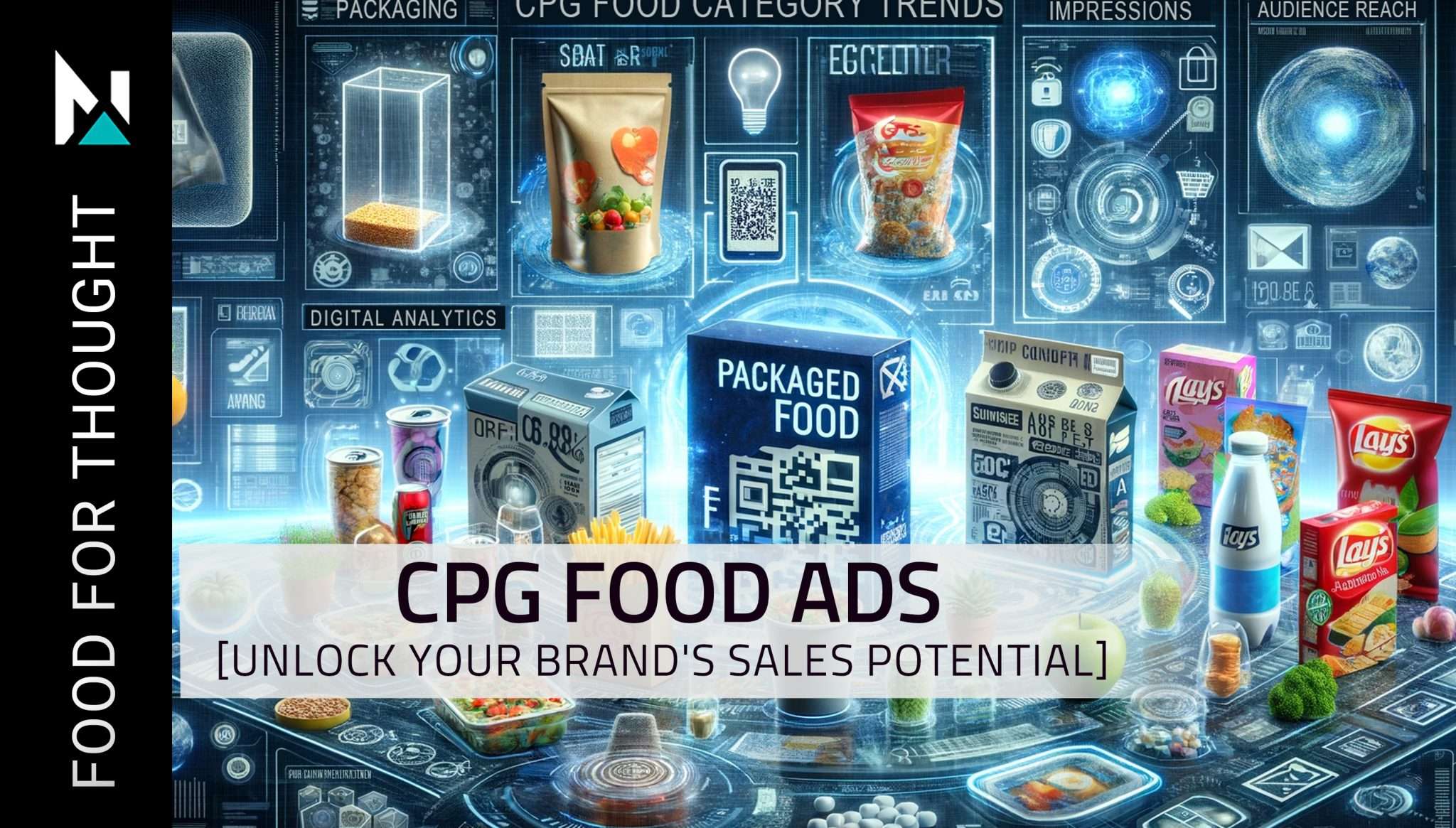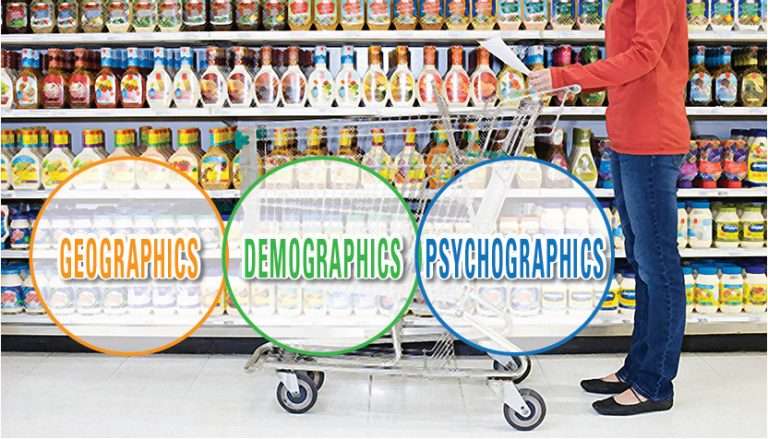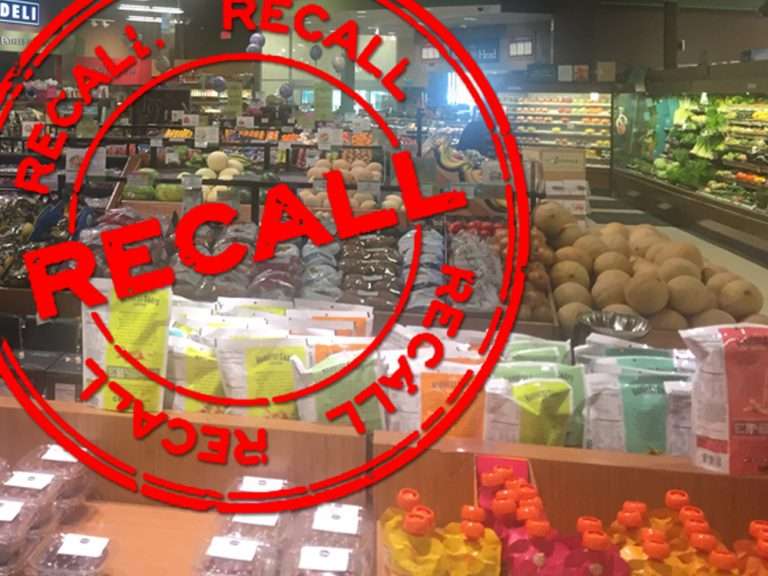Apr 10, 2024
CPG Food Ads: Unlock Your Brand’s Sales Potential
Unlocking the Sales Potential of Food Ads: A Guide for Food Marketing Professionals
Food ads are the best way to illustrate a brand’s message and potential to the target audience. Consequently, the Newpoint Marketing team has put together this comprehensive exploration of the effectiveness of food advertising. Additionally, food ads are pivotal in driving consumer engagement and sales for CPG brands in traditional retail and online sales.
Essentials Food Ads
Food ads are essential in transforming ordinary food products into compelling offerings that capture consumers’ attention. Moreover, food ads significantly influence consumer perceptions

and buying decisions. Also, this could be a compelling visual display in-store or a targeted digital campaign online.
Why are food ads important in today’s competitive marketplace?
Food ads are crucial for brand visibility and differentiation amidst a saturated landscape of food products. With consumers flooded by options, effective advertising is essential for carving out your brand’s distinct and memorable presence. This means employing strategies, principles, and best practices that support successful food advertising campaigns. Unlock the full sales potential of your CPG brands and establish a compelling presence in the dynamic realm of food marketing.
Understanding the Landscape of Food Advertising
In today’s dynamic marketing world, navigating the landscape of food advertising requires staying attuned to current trends and challenges. It’s essential to keep a pulse on consumers’ ever-evolving preferences and the rapidly changing digital platforms they engage with.
Food Ad Trends
Looking at current trends, we see a significant shift towards health-conscious choices and sustainability. Consumers are increasingly seeking transparency in food production and ingredients. Therefore, food advertisers must tailor their messages to resonate with these values, highlighting factors like organic ingredients, ethical sourcing, and eco-friendly packaging.
Market Challenges
Despite the opportunities, food advertisers face several challenges. One notable challenge is the saturation of the market, making it difficult to stand out amidst the noise. Also, the rise of ad-blocking software and regulations on data privacy present hurdles in effectively reaching target audiences.
It’s crucial to analyze successful food ad campaigns to overcome these challenges. By studying what works, marketers can glean valuable insights into crafting compelling narratives and leveraging the power of visuals to capture attention. Successful campaigns often tap into emotions, telling stories that resonate with consumers on a personal level.
Brand and Your Target Audience
However, success doesn’t come without pitfalls to avoid. Common food advertising mistakes include neglecting to fully understand the target audience, being overly promotional, and lacking authenticity. In today’s era of authenticity and transparency, consumers can quickly spot insincerity, making it imperative for advertisers to maintain genuine connections with their audience.
Understanding the landscape of food advertising requires a keen awareness of current trends, a deep analysis of successful campaigns, and an understanding of common mistakes to avoid. By staying informed and adaptable, food marketers can navigate this ever-changing terrain and effectively reach their target audience.
Target Audience Identification
Target Audience Identification holds a paramount position in the realm of creating food ads, serving as the cornerstone upon which successful campaigns are built. It encompasses a multifaceted approach that delves into the intricate nuances of consumer demographics, psychographics, and behaviors. Marketers can effectively tailor their messaging and strategies to resonate with their desired consumer segments by meticulously defining target audience personas.
Consumer Behavior and Preferences
Understanding consumer behavior and preferences lies at the heart of effective audience identification. Marketers can gain invaluable insights into the motivations, desires, and pain points of their target audience by utilizing advanced techniques such as market research, data analysis, and consumer surveys.. These insights serve as a guiding light, illuminating the path toward crafting compelling campaigns that strike a chord with consumers on a personal level.
Food Ads & Targeting Strategies
The importance of audience targeting strategies is underscored by their tangible impact on the success of food advertising initiatives. Case studies abound with examples of brands that have leveraged sophisticated targeting techniques to achieve remarkable results. Whether it’s a campaign aimed at health-conscious millennials, emphasizing the use of organic, sustainably sourced ingredients, or one targeting busy parents, highlighting the convenience and nutritional value of their products, the common thread is alignment with the specific needs and values of the target audience.
Embracing a Holistic Approach
Effective target audience identification is not merely a matter of demographics; it’s about understanding the intricate tapestry of human desires and motivations that drive consumer behavior. By embracing this holistic approach, food marketers can forge deeper connections with their target audience, fostering loyalty, driving engagement, and, ultimately, achieving long-term success in a competitive marketplace.
Crafting Compelling Food Ad Content
When it comes to creating impactful food advertisements, several key elements play a crucial role in capturing the attention of your audience. Firstly, ensure your content is visually appealing, with vibrant images that showcase your product in its best light. High-quality photography or videos can make a significant difference in drawing consumers in.
Branded content is essential
Secondly, focus on crafting concise and compelling copy that highlights the unique selling points of your product. Use language that resonates with your target audience, emphasizing the taste, quality, and benefits of your food item. Keep sentences short and impactful to maintain the reader’s interest.
Storytelling in food ads
Additionally, incorporating storytelling into your advertisements can elevate your content and create a deeper connection with consumers. Share the backstory of your brand or product, highlighting its origins, inspiration, and values. Authentic storytelling adds personality to your ads and helps consumers relate to your brand on a more emotional level.
Define your visual vocabulary
When it comes to visuals, aim for consistency in style and messaging across all platforms. Whether it’s social media, print ads, or digital campaigns, maintaining a cohesive visual identity reinforces brand recognition and fosters trust with consumers.
Effective food ad content combines captivating visuals, persuasive copy, and authentic storytelling to engage and entice consumers. By focusing on these key elements, you can create advertisements that stand out in a crowded marketplace and drive meaningful connections with your target audience.
Leveraging Digital Platforms for Food Advertising
In today’s dynamic landscape, digital marketing stands tall as a powerhouse for food advertising. From social media to targeted campaigns, the avenues are vast, offering unparalleled opportunities to connect with audiences.
Digital marketing channels
Firstly, let’s delve into the diverse array of digital marketing channels pertinent to the food industry. Social media platforms like Instagram, Facebook, and TikTok serve as virtual stages where brands can showcase their culinary creations, engage with followers, and spark cravings. Websites, blogs, and online marketplaces further extend the reach, providing a platform for storytelling and product showcases. Email marketing remains a stalwart, delivering personalized messages directly to consumers’ inboxes, enticing them with exclusive offers and delectable content.
Social media reach and engagement
Strategies for amplifying reach and engagement on social media platforms. Crafting visually enticing content is paramount, with high-quality images and videos grabbing attention amidst the scroll. Consistency in posting, coupled with strategic use of hashtags and interactive elements like polls and quizzes, fosters community engagement and brand loyalty. Collaborations with influencers and user-generated content initiatives add authenticity and broaden reach, tapping into niche audiences and amplifying brand advocacy.
The power of food ad analytics
Harness the power of data analytics to fine-tune digital ad campaigns for optimal results. Tracking key metrics like impressions, click-through rates, and conversions provides invaluable insights into consumer behavior and campaign effectiveness. A|B testing allows for experimentation and refinement, optimizing ad content, targeting parameters, and delivery timings. Leveraging tools like Google Analytics and social media insights empowers marketers to make data-driven decisions, allocating resources strategically and maximizing ROI.
Digital platforms provide a plethora of opportunities for food advertising. Social media, data analytics, and targeted campaigns are the pillars of success in this landscape. By embracing these strategies and staying abreast of emerging trends, food marketers can carve out their digital footprint. This approach tantalizes taste buds and drives brand growth in the dynamic digital realm.
Navigating Regulatory and Ethical Considerations
Navigating the realm of food marketing demands a delicate balance between creativity and compliance. It’s crucial for food marketing professionals to grasp the intricate web of legal restrictions and guidelines governing food advertising. From FDA regulations to FTC guidelines, staying abreast of these mandates ensures campaigns stay on the right side of the law.
Ethical considerations
Equally important are the ethical considerations inherent in food advertising. As guardians of public health, marketers have a duty to promote transparency and encourage healthy choices. This means steering clear of misleading claims and embracing authenticity in messaging. By prioritizing ethics, brands not only build trust with consumers but also contribute positively to public health discourse.
Food Ad Case Studies
Case studies offer invaluable insights into navigating regulatory and ethical considerations effectively. From iconic brands to emerging players, success stories abound for those who prioritize compliance and ethics in their marketing endeavors. These case studies serve as beacons of inspiration, demonstrating the tangible benefits of aligning marketing strategies with regulatory standards and ethical principles.
Mastering the intricacies of regulatory compliance and ethical marketing is essential for success in the food industry. By understanding legal restrictions, embracing ethical considerations, and drawing inspiration from successful case studies, food marketing professionals can navigate this complex landscape with confidence and integrity.
Measuring Success and ROI
As food marketing professionals, measuring success and return on investment (ROI) is essential to gauge the effectiveness of our advertising efforts. We rely on metrics to understand how well our ad campaigns are performing and whether they are driving the desired outcomes.
Evaluating food ads
To evaluate the effectiveness of our food ad campaigns, we focus on key metrics such as reach, engagement, and conversion rates. By tracking these metrics, we can assess the impact of our advertisements on our target audience and determine if they are resonating with them.
ROI tools and tips
Utilizing tools and methodologies for tracking ROI in food advertising is crucial for understanding the return we are getting on our investment. We leverage analytics platforms and attribution models to attribute conversions to specific ad campaigns accurately. This allows us to calculate the ROI of our advertising efforts and make informed decisions about where to allocate our resources.
At the heart of our strategy for enhancing the success of our food ad campaigns lies continuous improvement. Regular analysis of performance metrics enables us to pinpoint areas for optimization and refinement. Whether adjusting targeting parameters, refining ad creatives, or experimenting with different messaging, our commitment to iteration remains unwavering as we strive for superior results.
Measuring success and ROI in food advertising requires a strategic approach focused on metrics, tools, and continuous improvement. By monitoring key performance indicators, leveraging analytics tools, and refining our strategies based on data-driven insights, we can ensure that our ad campaigns are effective in driving the desired outcomes.
Future Trends in CPG Food Ads
In the ever-changing world of food advertising, adopting new technologies is vital for success. From immersive augmented reality to AI-driven campaigns, there are countless ways to engage audiences. Understanding consumer trends is crucial, especially with the rise of conscious consumerism. To connect with these evolving segments, marketers must adjust strategies to meet sustainability demands.
Stay ahead of the curve
Staying ahead of the curve requires a proactive approach rooted in agility and adaptability. Marketers can identify opportunities and tailor their advertising efforts to meet evolving demands. We consistently monitor industry trends, consumer insights, and technological developments. Moreover, data-driven insights empower brands to craft narratives that resonate with their target audience on a deeper level. The future of food advertising means focusing on remaining responsive to changing consumer dynamics to stay ahead in this competitive landscape.
Unleash Your Brand’s Sales Potential with CPG Food Ads
Mastering the art of food advertising is essential for food manufacturers and processors looking to thrive in today’s competitive market. By understanding the landscape of food advertising, businesses can create compelling content that resonates with consumers.
Crafting captivating visuals and engaging copy is key in capturing audience attention for widespread reach and engagement. However, it’s crucial to navigate regulatory and ethical considerations so food ads adhere to legal standards and promote transparency and healthy choices.
Measuring success through metrics and continuously refining strategies based on performance is key to achieving a high return on investment. As we look to the future, staying abreast of emerging technologies and consumer trends will be instrumental in staying ahead of the curve in food advertising.
Reach out to NewPoint Marketing today to incorporate these strategies into your marketing efforts to elevate your brand and position your business for long-term success.
Remember, effective food advertising is not just about selling products—it’s about creating meaningful connections with consumers and fostering brand loyalty. Let’s continue to innovate and push the boundaries of food advertising together.





